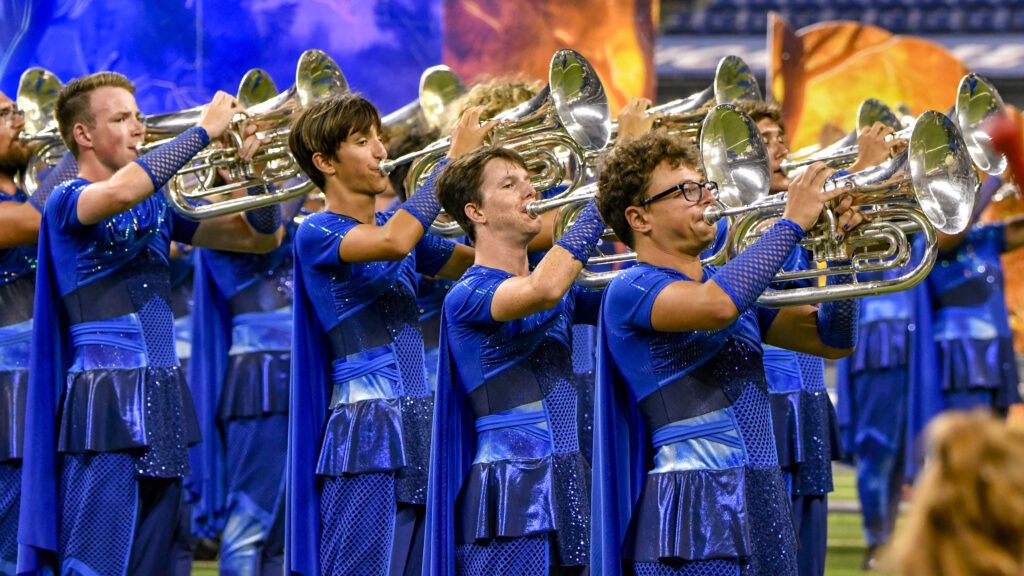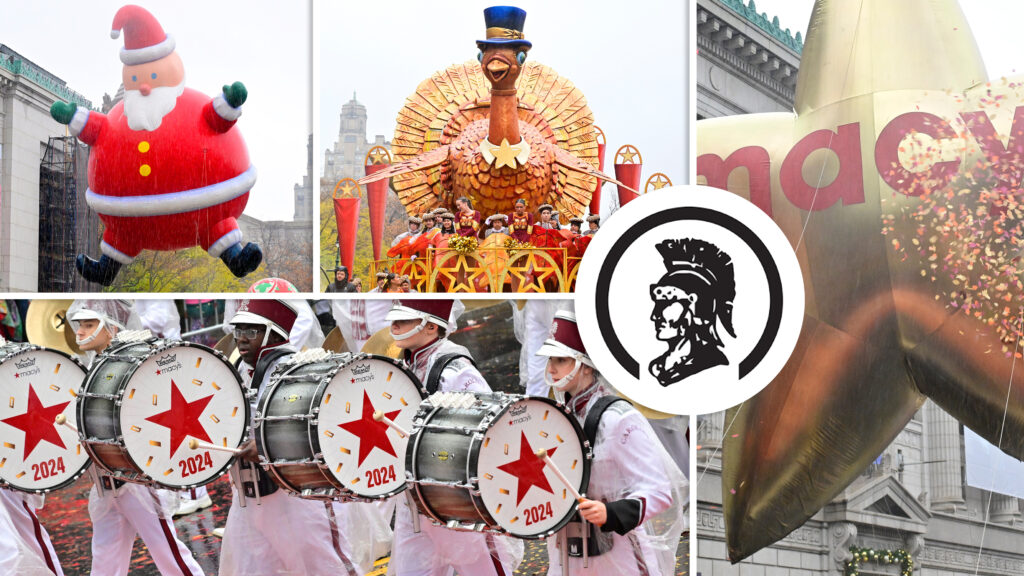If you weren’t aware of the subject matter going in, or missed public address announcer Brandt Crocker’s introduction of Spirit of Atlanta’s 2011 production, it didn’t take long for the corps to spell it out for you.
A show that opened with a jazzy, growling trumpet solo embodied its thematic concept from the start. It was mysterious, brooding and energetic.
“The audience, in the very first measure,” said Mark Waymire, Spirit’s director of education and programming, “will go, ‘Yeah, that’s Spirit of Atlanta.’”
The tone and feeling of the show was clear from the outset, but on the final, gut-punch chord of the corps’ opening statement, it couldn’t have been more obvious what this performance was portraying as it was written out across the football field in a drill formation — NOIR.
2011 Spirit of Atlanta’s “ATL Confidential: A Tribute to Film Noir,” was a journey through the dark alleys of cinema, touching on visual and musical characteristics of noir — defined as “a genre of crime film or fiction characterized by cynicism, fatalism, and moral ambiguity.”
A show which provided the backdrop for the corps’ return to the Top 12 finalist pool after a three-year hiatus, would be remembered for embodying the corps’ roots.

After a long stretch under the names Spirit of Georgia, Spirit from Jacksonville State University and simply Spirit, the corps made a return to its original name in 2011, Spirit of Atlanta. Running with a show concept that fit well with the corps’ history made perfect sense.
“As a design team, we kept pointing back to, ‘What are the single adjectives that you’d use to describe Spirit?’” Wilmore said. “And this year, we wanted to narrow it down to one word.”
“The word we chose,” he added, “was sultry.”
It ultimately sparked a three-year trend of that style of production. “ATL Confidential” was immediately followed in 2012 by a Las Vegas-themed production, “Sin City,” and 2013’s “Speakeasy,” which played on themes of the prohibition era.
It was a niche that clearly worked — each of those three years saw the Georgia corps land among the Top 12.

2011 Spirit of Atlanta | “ATL Confidential: A Tribute to Film Noir” 12th Place, 85.350
For 2011’s production, Spirit of Atlanta donned the same corps uniform it had introduced in 2010. Its color palette largely featured neutral paneling, with black on the left side and across the middle of the jacket and left sleeve, a white section across the top that connected with a gray right sleeve, and a splash of light blue in the jacket’s bottom right corner.
Topped off with a white shako and plume and black pants, Spirit’s 2011 uniform was a clean-cut and simple look that allowed its signature blue color to pop.
Meanwhile, color guard costuming utilized various fabrics and patterns in soft gray, shining silver and sleek black, in the look of mid-1900s night club attire.
From before the first note of the production, the stage was being set aurally, as scratchy music and sound effects from films of the noir genre created a mysterious and ominous tone. A sultry trumpet solo laid on top of a low, sustained, brooding note from the synthesizer, opened the door for an exciting and building opening movement.
Quick-moving drill formations and music that rose and fell dynamically grew toward a strong fanfare-esque opening statement, with the trumpets and mellophones forming the shape of Spirit’s “delta” logo at midfield.
Staccato music — featuring “Death at the Olympic” by Mark Isham, from the 2006 film, “The Black Dahlia” — and complex drill led into one of the show’s more iconic moments — an emphatic chord, with the full brass section spelling out the word “NOIR” on the field.

The show’s second movement was very percussive and carried somewhat of a late-night, dark, “investigative” feeling. Narration echoed over front ensemble percussion music and a front-and-center snare feature.
“Murder? I’ll be right there.”
An eerie sound effect — a high-pitched series of electronic tones from the front ensemble — led into a memorable feature moment that put Spirit’s brass prowess on display, as sections of the horn line traded complex runs before transitioning into the movement’s strong final push.
The end of movement two, and its subsequent transition into movement three, introduced a new character, a woman wearing a bright, sparkling red dress who emerged into the field from the front sideline.
She was met with beautiful ballad music — Jerry Goldsmith’s “Love Theme” from the 1974 film, “Chinatown” — as she slowly made her way into a love triangle, between herself, a member of the color guard, and the movement’s flugelhorn soloist.
Ultimately, after a powerful stage-right impact from the corps’ horn line, the featured character in red left the scene in anger, seeing her preferred love interest — the soloist, whose featured melody rounded out the memorable ballad movement — in the arms of another.

What followed was one of the more recognizable pieces of music from the production, Earle Hagan and Dick Rogers’ “Harlem Nocturne,” popularized to many by Duke Ellington.
An up-tempo and toe-tapping jazz number, this fourth movement brought the night club to life, with swinging music trading back and forth between brass and percussion sections, while color guard members danced front-and-center on and around white barstools.
The movement closed in strong Spirit fashion, with an impactful full-corps “park-and-bark” moment and screaming trumpet soloist, before dissolving into a scattered set across the front half of the field for a sustained, loud unison note.
As the closing section began, the party was over and the crime investigation reopened. The corps on the field outlined the shape of a person, akin to what one would see outlined in chalk at the scene of a crime. Meanwhile, fuzzy narrations — city streets can be a decent place, but not for long — followed by the sound of three gunshots and a high-pitched scream, set the tone for the show’s final sequences.
The high-speed final movement — featuring Bernard Hermann’s “Prelude,” from the 1951 film “On Dangerous Ground — took audiences on a chaotic and energetic ride, as sounds of police sirens and screeching car tires complimented Hermann’s intense work to create somewhat of a controlled-chaotic environment.
One more resonant siren led into a punching impact from the corps, as it reintroduced the music from its opening movement. Speed picked up as the corps performed a captivating visual effect, using follow-the-leader techniques to dissolve four lines into one company front.
The company front expanded on the show’s last measures of driving music, as the corps once again formed its iconic “delta” shape, opening space in the front of the field for its main character — the woman in red — to fire off one last gunshot, the last sound heard from Spirit’s 2011 production.

Back on Top (12)
Spirit of Atlanta was one of the 2011 season’s biggest movers and shakers, shooting up through the leaderboard from 16th in 2010 to 12th in 2011 to earn its first World Championship Finals bid since 2007.
“It seems like it’s been an eternity [since we were last in the World Championship Finals],” Spirit executive director Joel Vincent said. “Of course it’s only been since 2007, but those years have been a very long time for us. We’re very happy to be back.”
The process — as it often does for corps that make a major leap through the DCI rankings in a given year — happened gradually throughout the summer.
Spirit of Atlanta opened the season, in its second performance, about a point behind the previous year’s 12th-place finisher, Glassmen. The corps showed further promise throughout late June and early July, scoring within decent striking distance of 2010 finalists like Boston Crusaders and Madison Scouts, before ultimately turning heads with a July 8 head-to-head victory over Glassmen, by a strong margin of 1.25 points.
From there, Glassmen didn’t let up, but Spirit didn’t back down. The Ohio corps finished within 0.45 points of Spirit’s 12th-place finish at a San Antonio, Texas meeting of 22 of the year’s 23 World Class participants. That margin grew to 1.5 points the following week in Atlanta, as Spirit began to earn its stranglehold on the final Top 12 position.
When all was said and done, Spirit stormed its way into Finals, outscoring the 13th-place Glassmen by more than three points in Semifinals competition. The corps’ strengths on the judges’ sheets came in general effect and percussion, both of which earned 11th overall.
“Ever since I started marching, my dream was just to be there Saturday night and perform in front of the [Finals] crowd, and I made it,” said Spirit of Atlanta cymbal player Caitlin Boline following the corps’ 2011 Finals performance. “This corps made it, and we’re back.”





